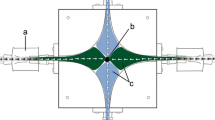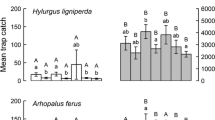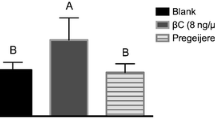Abstract
The redbay ambrosia beetle, Xyleborus glabratus Eichhoff, is an exotic wood-boring insect that vectors the mycopathogen responsible for laurel wilt, a lethal vascular disease of trees in the Lauraceae. High mortality has occurred in native Persea species in the southeastern U.S., and the vector-pathogen complex poses an imminent threat to the production of commercial avocado, P. americana, in south Florida. There is a critical need for effective attractants to detect, monitor, and control this invasive pest. This study combined field tests and laboratory bioassays to evaluate the response of female X. glabratus to host-based volatiles from wood of avocado (cultivars of West Indian, Guatemalan, and Mexican races); from wood of lychee (Litchi chinensis, a presumed non-host that is high in the sesquiterpene α-copaene, a putative attractant); and to commercial lures containing manuka and phoebe oils, two reported attractive baits. Volatile collections and GC-MS analyses were performed to quantify the sesquiterpene content of test substrates. In the field, traps baited with lychee wood captured more beetles than those with wood from avocado cultivars; traps baited with phoebe oil lures captured more beetles than those with manuka oil lures (the current monitoring tool). In field and laboratory tests, X. glabratus did not show a preference among avocado races in either attraction or host acceptance (initiation of boring). In choice tests, lychee was more attractive than avocado initially, but a higher percentage of beetles bored into avocado, suggesting that lychee emits more powerful olfactory/visual cues, but that avocado contains more of the secondary cues necessary for host recognition. Emissions of α-copaene, β-caryophyllene, and α-humulene were correlated with field captures, and lychee wood may be a source of additional semiochemicals for X. glabratus.




Similar content being viewed by others
References
Box, G. E. P., Hunter, W. G., and Hunter, J. S. 1978. Statistics for Experimenters. An Introduction to Design, Data Analysis, and Model Building. J. Wiley & Sons, New York.
CISEH. 2010. Forestry images. Lindgren funnel trap. Center for Invasive Species and Ecosystem Health, USDA Forest Service, and International Society of Arboriculture. <http://www.forestryimages.org/browse/detail.cfm?imgnum=5426963>.
Evans, E. A. and Crane, J. H. 2008. Estimation of the replacement costs of commercial and backyard avocado trees in south Florida. Circular FE 825. University of Florida, Department of Food and Resource Economics. <http://edis.ifas.ufl.edu/pdffiles/FE/FE82500.pdf>.
FDACS-DPI. 2010. Firewood movement rule (5B-65). Florida Department of Agriculture and Consumer Services, Division of Plant Industry. Cooperative Agricultural Pest Survey Program. <http://www.freshfromflorida.com/pi/caps/firewood.html>.
FDACS. 2011. Laurel wilt disease identified in Miami-Dade County. Press Release, 25 February 2011. Florida Department of Agriculture and Consumer Services. <http://www.freshfromflorida.com/press/2011/02252011.html>.
Fraedrich, S. W., Harrington, T. C., Rabaglia, R. J., Ulyshen, M. D., Mayfield iii, A. E., Hanula, J. L., Eickwort, J. M., and Miller, D. R. 2008. A fungal symbiont of the redbay ambrosia beetle causes a lethal wilt in redbay and other Lauraceae in the southeastern United States. Plant Dis. 92:215–224.
Hanula, J. L. and Sullivan, B. 2008. Manuka oil and phoebe oil are attractive baits for Xyleborus glabratus (Coleoptera: Scolytinae), the vector of laurel wilt. Environ. Entomol. 37:1403–1409.
Hanula, J. L., Mayfield Iii, A. E., Fraedrich, S. W., and Rabaglia, R. J. 2008. Biology and host associations of the redbay ambrosia beetle (Coleoptera: Curculionidae: Scolytinae), exotic vector of laurel wilt killing redbay trees in the southeastern United States. J. Econ. Entomol. 101:276–1286.
Harrington, T. C., Fraedrich, S. W., and Aghayeva, D. N. 2008. Raffaelea lauricola, a new ambrosia beetle symbiont and pathogen on the Lauraceae. Mycotaxon 104:399–404.
Harrington, T. C., Aghayeva, D. N., and Fraedrich, S. W. 2010. New combinations of Raffaelea, Ambrosiella, and Hyalorhinocladiella, and four new species from the redbay ambrosia beetle, Xyleborus glabratus. Mycotaxon 111:337–361.
Heath, R. R. and Manukian, A. 1992. Development and evaluation of systems to collect volatile semiochemicals from insects and plants using a charcoal-infused medium for air purification. J. Chem. Ecol. 18:1209–1226.
Heath, R. R., Manukian, A., Epsky, N. D., Sivinski, J., Calkins, C. O., and Landolt, P. J. 1993. A bioassay system for collecting volatiles while simultaneously attracting tephritid fruit flies. J. Chem. Ecol. 19:2395–2410.
Heath, R. R., Vázquez, A., Espada, C., Kendra, P. E., and Epsky, N. D. 2007. Quantification of ammonia release from fruit fly (Diptera: Tephritidae) attractants using infrared spectroscopy. J. Econ. Entomol. 100:580–585.
Hosni, K., Msaada, K., Taarit, M. B., Ouchikh, O., Kallel, M., and Marzouk, B. 2008. Essential oil composition of Hypericum perfoliatum L. and Hypericum tomentosum L. growing wild in Tunisia. Ind. Crops Prod. 27:308–314.
Ibrahim, M. A., Egigu, M. C., Kasurinen, A., Yahya, A., and Holopainen, J. K. 2010. Diversity of volatile organic compound emissions from flowering and vegetative branches of Yeheb, Cordeauxia edulis (Caesalpiniaceae), a threatened evergreen desert shrub. Flavour Fragr. J. 25:83–92.
Jacobi, W. R. and Macdonald, W. L. 1980. Colonization of resistant and susceptible oaks by Ceratocystic fagacearum. Phytopathology 70:618–623.
Karlsson, M. F., Birgersson, G., Cotes Prado, A. M., Bosa, F., Bengtsson, M., and Witzgallo, P. 2009. Plant odor analysis of potato: response of Guatemalan moth to above- and below ground potato volatiles. J. Agric. Food Chem. 57:5903–5909.
Kendra, P. E., Sanchez, J. S., Montgomery, W. S., Okins, K. E., Niogret, J. Peña, J. E., Epsky, N. D., and Heath, R. R. 2011. Diversity of Scolytinae (Coleoptera: Curculionidae) attracted to avocado, lychee, and essential oil lures. Florida Entomol. 94:123–130.
Lindgren, B. S. 1983. A multiple funnel trap for scolytid beetles (Coleoptera). Can. Entomol. 115:299–302.
Mayfield iii, A. E., Peña, J. E., Crane, J. H., Smith, J. A., Branch, C. L., Ottoson, E. D., and Hughes, M. 2008. Ability of the redbay ambrosia beetle (Coleoptera: Curculionidae: Scolytinae) to bore into young avocado (Lauraceae) plants and transmit the laurel wilt pathogen (Raffaelea sp.). Florida Entomol. 91:485–487.
Miller, D. R. and Rabaglia, R. J. 2009. Ethanol and (−)-α-pinene: attractant kairomones for bark and ambrosia beetles in the southeastern U.S. J. Chem. Ecol. 35:435–448.
Niogret, J., Montgomery, W. S., Kendra, P. E., Heath, R. R., and Epsky, N. D. 2011. Attraction and electroantennogram responses of male Mediterranean fruit fly (Diptera: Tephritidae) to volatile chemicals from Persea, Litchi and Ficus wood. J. Chem. Ecol. 37:483–491.
Petrice, T. R., Haack, R. A., and Poland, T. M. 2004. Evaluation of three trap types and five lures for monitoring Hylurgus ligniperda (Coleoptera: Scolytidae) and other local scolytids in New York. Great Lakes Entomol. 37:1–9.
Porter, N. G. and Wilkins, A. L. 1998. Chemical, physical and antimicrobial properties of essential oils of Leptospermum scoparium and Kunzea ericoides. Phytochemistry. 50:407–415.
Rabaglia, R. J. 2002. XVII. Scolytinae Latreille 1807, pp. 792–805, in R. H. Arnett, Jr., M. C. Thomas, P. E. Skelley, and J. H. Frank (eds.). American Beetles, Vol. 2, Polyphaga: Scarabaeoidea through Curculionoidea. CRC Press, Boca Raton.
Rabaglia, R. J., Dole, S. A., and Cognato, A. I. 2006. Review of American Xyleborina (Coleoptera: Curculionidae: Scolytinae) occurring north of Mexico, with an illustrated key. Ann. Entomol. Soc. America 99:1034–1056.
SAS INSTITUTE. 2001. SAS/STAT Guide for Personal Computers, ver. 8.2. SAS Institute, Cary, NC.
Singh, G., Marimuthu, P., De Heluani, C. S., and Catalan, C. A. N. 2007. Chemical constituents, antioxidative and antimicrobial activities of essential oil and oleoresin of tailed pepper (Piper cubeba L.). Int. J. Food Eng. 3:1–22.
SYSTAT SOFTWARE. 2006a. SigmaPlot 10 User’s Manual. Systat Software, Point Richmond, CA.
SYSTAT SOFTWARE. 2006b. SigmaStat 3.5 User’s Manual. Systat Software, Point Richmond, CA.
Tokushima, I., Orankonok, W., Tan, K. H., and Nishida, R. 2010. Accumulation of phenylpropanoid and sesquiterpenoid volatiles in male rectal pheromonal glands of the guava fruit fly, Bactrocera correcta. J. Chem. Ecol. 36:1327–1334.
UN. 2010. Commodity Trade Statistics Database (COMTRADE). United Nations Statistics Division. <http://comtrade.un.org/db>.
USDA-FAS. 2010. Mexico avocado annual record production forecast for marketing year 2010/11. Global Agricultural Information Network (GAIN) Report MX0088. United States Department of Agriculture, Foreign Agricultural Service. <http://gain.fas.usda.gov/Recent%20GAIN%20Publications/Avocado%20Annual_Mexico%20City_Mexico_12-1-2010.pdf>.
USDA-FS. 2011. Laurel wilt distribution. United States Department of Agriculture, Forest Service, Forest Health Protection, Southern Region. <http://www.fs.fed.us/r8/foresthealth/laurelwilt/dist_map.shtml>.
USDA-NASS. 2011. Noncitrus fruits and nuts: 2010 preliminary summary. United States Department of Agriculture, National Agricultural Statistic Service. <http://usda.mannlib.cornell.edu/usda/current/NoncFruiNu/NoncFruiNu-01-21-2011.pdf>.
Acknowledgments
We gratefully acknowledge Jorge Sanchez, David Long, Ricardo Joseph, Mike Winterstein (USDA-ARS; Miami, FL), and Stephen McLean (Univ. Florida; Gainesville, FL) for technical assistance; Kate Okins and Patti Anderson (FDACS-DPI; Gainesville, FL) for identifications of ambrosia beetles and Persea, respectively; Ray Schnell (USDA-ARS; Miami, FL) for advice on avocado germplasm samples; Bud Mayfield (USDA-Forest Service; Asheville, NC), Lukasz Stelinski (Univ. Florida; Lake Alfred, FL), and two anonymous referees for critical reviews of the manuscript; and Connie Rightmire (St. John’s River Water Management District; Palatka, FL) for assistance in obtaining a special use permit for the Lochloosa Wildlife Conservation Area. This work was supported in part by the USDA-ARS National Plant Disease Recovery System, a NIFA Critical Issues Grant, and the Florida Avocado Administrative Committee. This report presents the results of research only; mention of a proprietary product does not constitute an endorsement by the USDA.
Author information
Authors and Affiliations
Corresponding author
Rights and permissions
About this article
Cite this article
Kendra, P.E., Montgomery, W.S., Niogret, J. et al. Attraction of the Redbay Ambrosia Beetle, Xyleborus glabratus, to Avocado, Lychee, and Essential Oil Lures. J Chem Ecol 37, 932–942 (2011). https://doi.org/10.1007/s10886-011-9998-0
Received:
Revised:
Accepted:
Published:
Issue Date:
DOI: https://doi.org/10.1007/s10886-011-9998-0




